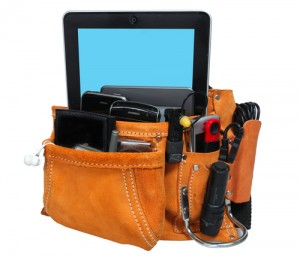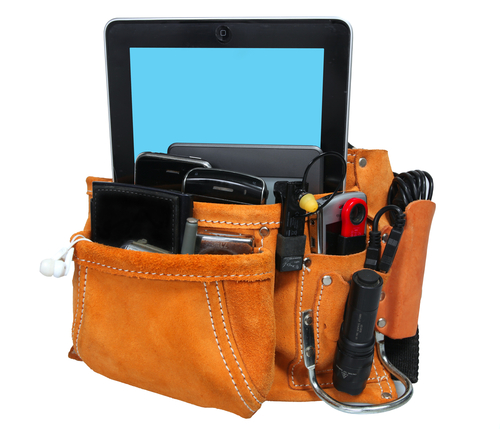 Almost everyone I talk to in the Service Industries is looking for the ideal Field Service Mobility solution for their business. However, when I ask them what that means, their definitions of Field Service Mobility vary greatly. Some see Mobility as the equivalent of a paper service docket on an iPad; others see Mobility as the ability to capture photo and technical information about site faults; some see Mobility as in-field timesheet tracking; while some go for the end-to-end call lifecycle captured electronically while on site. Fundamentally, it is critical to remember that a Field Service Mobility system doesn’t have to be the same as your ERP/Business software system and they aren’t, in fact, one and the same thing.
Almost everyone I talk to in the Service Industries is looking for the ideal Field Service Mobility solution for their business. However, when I ask them what that means, their definitions of Field Service Mobility vary greatly. Some see Mobility as the equivalent of a paper service docket on an iPad; others see Mobility as the ability to capture photo and technical information about site faults; some see Mobility as in-field timesheet tracking; while some go for the end-to-end call lifecycle captured electronically while on site. Fundamentally, it is critical to remember that a Field Service Mobility system doesn’t have to be the same as your ERP/Business software system and they aren’t, in fact, one and the same thing.
All those definition differences make it tricky when you try to approach a vendor for a software solution. You could both be saying the words “Mobility”, but assuming two completely different scenarios. You could waste a lot of time talking at cross-purposes and even end up agreeing to and purchasing a product that only meets a small percentage of your business needs. By the time you realise that, it’s often too late and you have to live with a badly fitting product.
If you want to successfully select and implement a Field Service Mobile Solution, the key is to be clear about your needs. You need to make sure you have your thoughts and story straight both internally, as well as when you’re communicating with your vendor.
Before you start…
1) Clarify your definition of Field Service Mobility.
What does the idea of Field Service Mobility mean to your business? What do people internally expect? Is it data on a smartphone/tablet? Or is it just a smarter way of managing all your forms? If you are focused on “data on a smartphone/tablet”, be specific to the point of knowing which forms or processes or screens you expect your techs to see and use.
Make sure there are no internal assumptions about what will be delivered, or you’ll doom the change project to failure before it starts.
2) Work out your “must-haves” and “nice-to-haves”.
List out the functions and processes that aren’t negotiable, that are key to the success of the new technology. These are your “must-haves”. Give them a ranking, so that you know which ones you need to prioritise and which ones you can re-work/re-think, if needed. If a vendor can’t meet one of these, that’s your warning sign to back away and try someone else.
Once you have your “must-haves” clear, work on your wish list. These are the things you would love to include, but if you can’t, they won’t impact the success of the solution, These “nice-to-haves” will be very useful if you’re lucky enough to be able to choose between multiple vendors who meet your “must-haves”. They’ll help you to determine which vendor can provide a solution that will grow and change with your business.
When you’re choosing…
3) Don’t compromise.
Pick the product that gives you at least 90% of your needs and always gives you all of your top priority must-haves. Don’t let yourself be talked around by a vendor into buying something that meets anything less, even if it does one of your needs incredibly well. While it might seem attractive in the short-term, a mismatched solution will get abandoned by the business over time.
4) Don’t believe the hype
Don’t just accept the flashy demo. Make sure you get to touch and feel and actually see how the product works. If you can, see if you can talk to a reference site, but make sure it’s one with a similar business model to your own.
While you’re implementing…
5) Remember your back office
The processes your service techs use in the field start and end up back in the office. Make sure you consider what the back office system needs in order to get information to your mobility solution and to receive information from it. Don’t make efficiency gains in the field and then waste them with an inefficient back of house.
6) Start small
Don’t try to rollout a new solution to all your techs at once. And don’t try to change too many processes on the first stage. It’s easy to be tempted by initial rollout success and want to push the change out to everyone really quickly, however, this can make the change harder to manage and support. So do it in steps. Let one change bed down before you take on the next.
The right Field Service Mobility solution can bring substantial financial and operational benefits to a Service business, but only if you’ve taken the time to clarify your needs. What does Field Service Mobility mean to your business? And how can it provide you with productivity efficiency both in the field and in the back office? Don’t let yourself be taken in by the glamour and hype of all the products out there. Make sure you invest the time up front to find the right product for your business and then roll out the change in bite-size chunks, ensuring acceptance and providing measureable benefits.
Do you need help implementing business change? Contact Business System Alchemy for more information by clicking here.
![]() The Alchemist is Ruxana D’Vine and Michael Meryment, specialists in matching business needs to technology.
The Alchemist is Ruxana D’Vine and Michael Meryment, specialists in matching business needs to technology.

